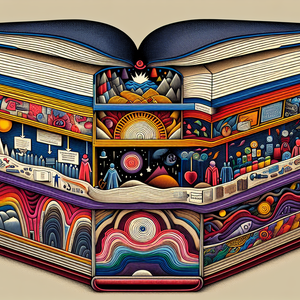The Classroom of the Future: Transforming Learning with Innovative Technologies

One of the most groundbreaking technologies making waves in classrooms is Virtual Reality (VR). VR allows students to immerse themselves in different environments and scenarios, thereby enhancing experiential learning. For instance, history classes can take virtual field trips to ancient civilizations, allowing students to explore the pyramids of Egypt or the ruins of Rome as if they were actually there. A study conducted by the University of Maryland found that students who experienced lessons through VR scored 30% higher on assessments compared to those who learned through traditional methods. This technology not only captivates students’ interest but also deepens their understanding by providing them with experiences that textbooks alone cannot offer. By bringing lessons to life, VR empowers students to engage with the material in a meaningful way.
Adaptive Furniture for Flexible Learning
The design of classroom furniture is also evolving, with a focus on adaptability and flexibility. Traditional desks and chairs are being replaced with modular furniture that can be easily rearranged to accommodate various teaching styles and activities. For example, schools are incorporating standing desks, bean bags, and collaborative workstations that promote movement and interaction among students. Research shows that when students have the freedom to choose where and how they learn, their engagement levels rise significantly. A case study from a progressive school district demonstrated that classrooms designed with flexible seating arrangements led to a 20% increase in student participation and collaboration during group activities. This adaptability not only caters to different learning preferences but also cultivates a sense of ownership over the learning environment.
Integrating Technology in Learning
The integration of technology into everyday learning is another key aspect of the classroom of the future. Smartboards, tablets, and educational software are becoming commonplace, providing interactive and personalized learning experiences. For instance, platforms like Kahoot! and Nearpod allow teachers to create engaging quizzes and interactive lessons that can be accessed by students on their devices. This shift caters to diverse learning styles and prepares students for a future in which digital literacy will be essential. In a recent survey, 85% of educators reported that using technology in the classroom has enhanced student engagement and motivation. As students become more adept at using these tools, they also develop critical skills such as problem-solving and collaboration.
Collaborative Learning Spaces
The future classroom is not just about individual learning; it’s also about collaboration. Schools are increasingly designing spaces that encourage teamwork and communication among students. Open areas with movable furniture, whiteboard walls, and breakout rooms facilitate group projects and discussions. According to a report by the Brookings Institution, collaborative learning has been linked to improved critical thinking and problem-solving skills. By working together, students learn to articulate their ideas, listen to others, and negotiate solutions, preparing them for real-world challenges. This shift towards collaborative learning spaces reflects a growing understanding that teamwork and communication are vital skills in today’s interconnected world.
Sustainability in Classroom Design
As we look to the future, sustainability is becoming a crucial element in classroom design. Schools are adopting eco-friendly materials and energy-efficient technologies to create healthier learning environments. This includes using natural light, incorporating greenery into the classroom, and utilizing sustainable building practices. Studies suggest that students learn better in environments that are well-lit and connected to nature. Furthermore, by teaching students about sustainability through their classroom environment, educators can foster a sense of responsibility towards the planet. This commitment to sustainability not only benefits students' learning experiences but also instills in them an awareness of their role in promoting environmental stewardship.
The classroom of the future is not just a vision; it is a reality that is unfolding before our eyes. Through innovative technologies, flexible designs, and a focus on collaboration and sustainability, educators are creating environments that enhance learning and engagement. As we continue to embrace these changes, it is essential to remember that at the heart of education lies the goal of nurturing curious, creative, and capable individuals. By transforming our classrooms, we are not merely adapting to a changing world; we are preparing our students to thrive within it. The future of education is bright, filled with possibilities that will shape the next generation of learners, and ultimately redefine what it means to teach and learn in a rapidly evolving society.
Educational Technology Specialist
School districts, educational non-profits, and EdTech companies
Core Responsibilities
Develop and implement technology integration strategies to enhance teaching and learning.
Provide training and support to teachers on the effective use of educational technology tools.
Assess the effectiveness of technology initiatives and recommend improvements based on data and feedback.
Required Skills
Strong understanding of current educational technologies and pedagogical practices.
Proficiency in data analysis and the ability to interpret metrics related to technology usage.
Experience with platforms like Google Classroom or Learning Management Systems (LMS).
Instructional Designer
Universities, corporate training departments, and online learning platforms
Core Responsibilities
Design and develop engaging educational content and learning experiences using various technologies.
Collaborate with educators to identify learning needs and create tailored instruction materials.
Evaluate the effectiveness of instructional materials and make data-driven adjustments.
Required Skills
Proficiency in instructional design software (e.g., Articulate Storyline, Adobe Captivate).
Strong knowledge of adult learning theories and instructional design methodologies (ADDIE, SAM).
Excellent communication and project management skills.
Classroom Designer/Space Planner
School districts, architectural firms, and educational consultancy firms
Core Responsibilities
Analyze and redesign classroom layouts to support flexible learning environments and collaboration.
Collaborate with educators and administrators to ensure designs meet pedagogical needs.
Source and recommend appropriate furniture and technology solutions that enhance classroom functionality.
Required Skills
Background in interior design or architecture, with a focus on educational spaces.
Understanding of educational theories related to classroom design and student engagement.
Proficiency in design software (e.g., AutoCAD, SketchUp).
Sustainability Coordinator in Education
School districts, universities, and environmental organizations
Core Responsibilities
Develop and implement sustainability initiatives within educational institutions, focusing on energy efficiency and waste reduction.
Educate students and staff on sustainable practices and their impact on the environment.
Collaborate with administrative teams to integrate sustainability into the curriculum and school culture.
Required Skills
Knowledge of environmental science and sustainable practices in educational settings.
Strong project management and communication skills to effectively promote initiatives.
Experience with sustainability certifications (e.g., LEED, Green Schools).
Virtual Reality (VR) Content Developer for Education
EdTech companies, gaming studios focusing on educational content, and educational institutions integrating VR into their curriculum
Core Responsibilities
Create immersive VR experiences and simulations for educational purposes across various subjects.
Collaborate with educators to align VR content with curriculum standards and learning objectives.
Test and evaluate VR applications to ensure they meet user needs and learning outcomes.
Required Skills
Proficiency in VR development tools (e.g., Unity, Unreal Engine).
Strong understanding of 3D modeling and animation principles.
Familiarity with educational theories and how VR can enhance learning experiences.


